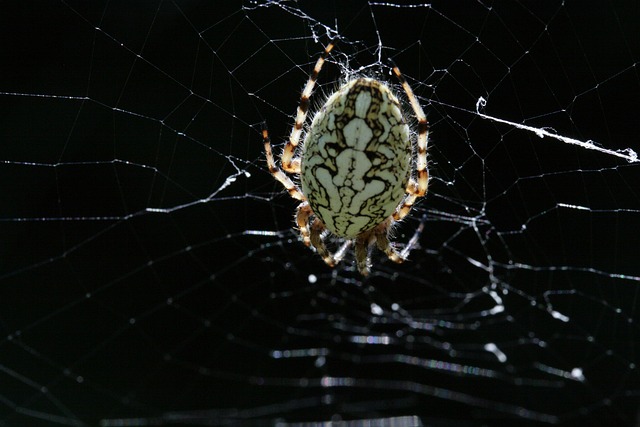Residential spider web cleaning is vital for hygiene and safety, requiring proper techniques and protective gear. Professional services offer tailored solutions, addressing egg sacs, and using safe methods like vacuum suction or warm water detergent solutions. Post-cleaning, sealing entry points, regular decluttering, and lighting deter spiders. Maintaining a tidy home environment prevents future infestations.
Tackling spider webs in your residential space? It’s more than just a nuisance—they signal a potential pest problem. This guide covers safe and effective techniques for tackling these sticky situations, from understanding common web types found in homes to essential gear for protection during removal. Learn proven methods using the right tools and steps for thorough cleaning, followed by preventative strategies to keep spiders at bay. Discover how to effectively address residential spider web cleaning.
Understanding Spider Webs: Types and Common Areas in Residential Spaces
Spider webs are intricate structures that can be found in various types and forms across residential spaces. In homes, spiders often construct their webs in areas offering protection from predators and ample food sources. Common spots include corners, behind furniture, under shelves, and along ceiling beams. Webs made by different spider species vary in appearance; some are dense and sticky, while others are more open and delicate. Identifying the type of web can help in selecting the appropriate removal technique. For instance, silken webs that trap insects can be challenging to clean due to their stickiness, necessitating specific tools and methods to avoid damaging surfaces or causing injury.
Regular residential spider web cleaning is essential for maintaining a hygienic living environment. While some people might attempt to remove webs on their own using brooms or vacuum cleaners, these methods can spread spider eggs or provoke aggressive behavior from resident spiders. Professional pest control services specializing in residential spider web cleaning offer safer and more effective solutions tailored to different web types and locations. This approach ensures not only the removal of visible webs but also addresses hidden egg sacs, preventing future infestations.
Safety First: Protective Gear and Precautions for Removal
When tackling spider web removal, especially in a residential setting, safety should always be the top priority. Spider webs can be more than just an eyesore; they can harbor dangerous arachnid inhabitants. Protecting yourself is crucial to prevent bites and potential health risks associated with both spiders and their silk. Before attempting any cleaning, gather appropriate personal protective equipment (PPE), including gloves designed for handling hazardous materials, a long-sleeved shirt, pants, closed-toe shoes, and a face mask or respirator if there’s a risk of inhaling web particles.
For residential spider web cleaning, ensure proper ventilation in the area to minimize the risk of respiratory issues. If possible, remove webs outside to avoid tracking them indoors. In cases where spiders are present, be cautious and respectful; not all species are harmful, but it’s best to leave re-locating or removing them to professionals if you’re unsure. After donning your PPE, use a vacuum cleaner with a brush attachment to carefully suck up webs, ensuring that the machine is properly equipped to handle fine debris without releasing it back into the air.
Effective Techniques: Tools and Steps for Thorough Cleaning
When it comes to effective residential spider web cleaning, the right tools and techniques make all the difference. Start by arming yourself with a sturdy ladder, as many webs are located high up on walls or in corners that require elevated access. Safety should always be your top priority, so ensure you have a stable platform to work from. Next, prepare a solution of warm water and mild detergent; this gentle mixture is effective for dissolving silk without damaging surfaces.
Dampen a microfiber cloth or sponge in the solution and gently wipe down web-infested areas. For more stubborn webs, use a small brush to loosen the silk before wiping it away. Pay special attention to corners, crevices, and dark spaces where spiders often build their intricate structures. After cleaning, thoroughly rinse your tools and dispose of any soiled rags responsibly. Regular maintenance and proactive removal will significantly reduce spider activity in your home, keeping both you and your family safe from potential bites.
Prevention Strategies: Keeping Spiders at Bay After Cleaning
After successfully cleaning a space of spider webs, implementing prevention strategies is key to maintaining a spider-free environment in your home. One effective method is to seal entry points and cracks where spiders might find their way in. This includes checking windows, doors, and any gaps around pipes or wires. Using weatherstripping, screens, or caulk can prevent these eight-legged intruders from reentering.
Regular cleaning and decluttering are also essential. Spiders thrive in dark, secluded spaces, so keeping areas clean and well-lit can deter them. Removing clutter provides fewer hiding spots, making it harder for spiders to establish their webs. Additionally, maintaining a tidy garden with no debris or dense vegetation nearby can significantly reduce the risk of spider infestations, as they often use these as bridges to enter homes.
When it comes to residential spider web cleaning, a comprehensive approach is key. By understanding different types of webs and common hiding spots, you can effectively employ safe and practical techniques using the right tools. Always prioritize safety with protective gear, and remember that prevention is just as important to keep spiders at bay after a thorough cleanout. These strategies ensure a spider-free environment, enhancing your home’s comfort and hygiene.
